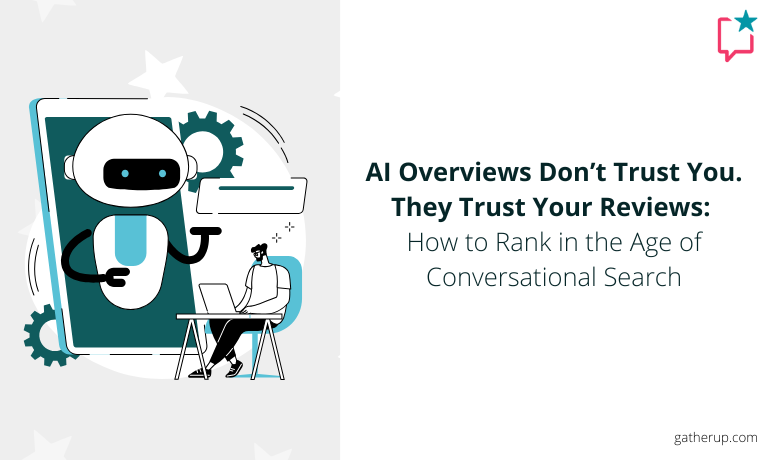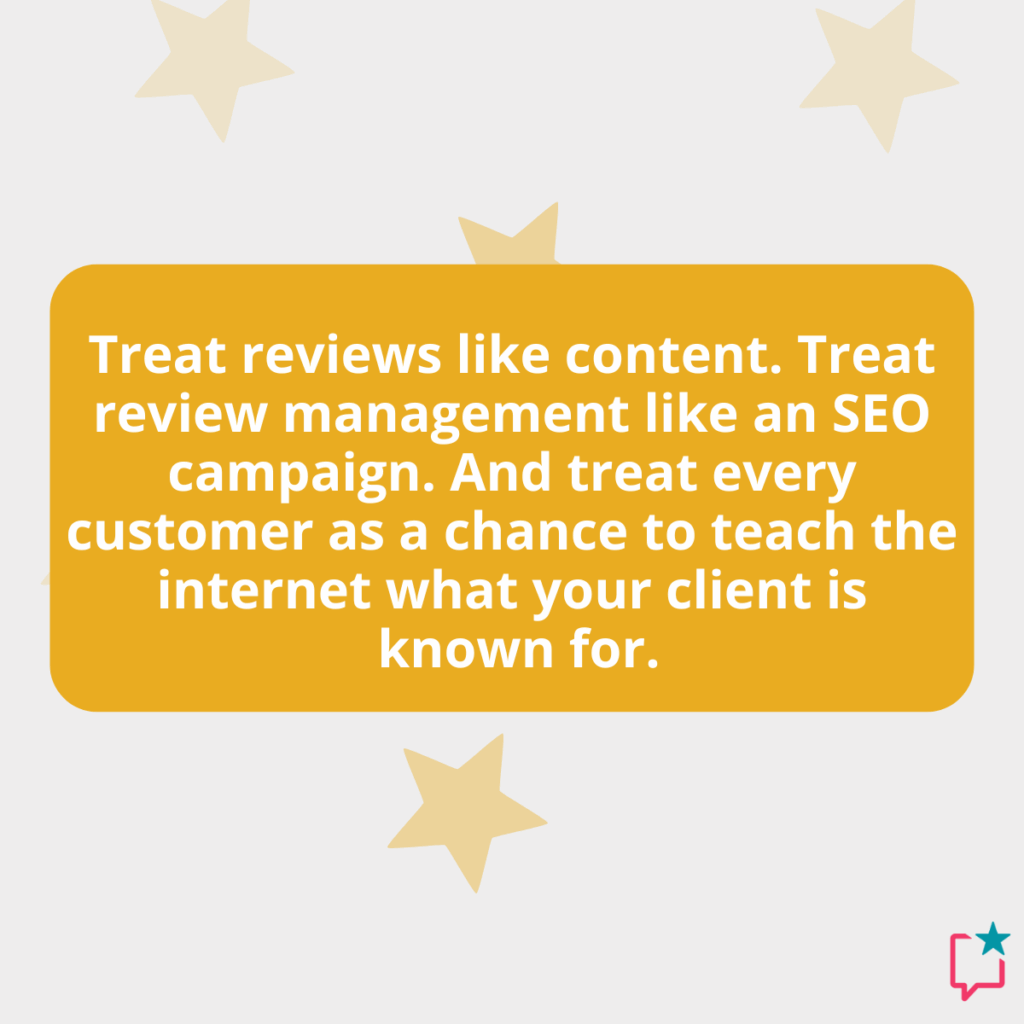
It used to be that local SEO was a game of citations, links, and maybe a little magic. But things have changed. Today, if your client’s business isn’t being talked about by customers on the right platforms, it’s invisible—not just to people, but to the algorithms that now shape what gets seen.
Enter AI Overviews (AIOs).
From Keywords to Conversations: The New Discovery Default
Search has shifted from static keywords to fluid, conversational questions. People no longer type in generic phrases like “dentist near me.” Instead, they ask: “Who’s the best family dentist in Tempe that’s good with kids and doesn’t overcharge?”

Google’s AI Overviews—part of its Search Generative Experience—aim to answer these questions by summarizing what the web says. And guess what forms the bulk of those summaries?
That’s right: reviews.
AI doesn’t guess. It can’t form opinions. Instead, it leans on signals—especially signals that come from other people. Which means reviews are no longer just about building trust with prospective customers. They’re now a core part of how search engines evaluate, describe, and rank your client’s business.
So if your strategy still treats reviews like a conversion asset at the bottom of the funnel, it’s time to recalibrate.
The Anatomy of an AIO: What Really Gets Summarized
Let’s dig deeper into what Google’s AIOs appear to prioritize when generating those slick, conversational summaries.
1. Review Volume and Velocity
A steady stream of reviews signals that a business is active, responsive, and engaging with customers. Agencies should help clients create daily or weekly review momentum, not bursts. According to GatherUp’s benchmark data, businesses that proactively request reviews can increase volume by 2–3x compared to those that rely on passive collection.

2. Review Recency
Our November 2024 survey of 1,200 consumers found that 67% prioritized recent reviews when making local business decisions. In contrast, Google’s average star rating algorithm dilutes freshness. AIO fills that gap by leaning into what’s new.
3. Keyword-Rich Descriptions
It’s not just what the reviews say, it’s how they say it. Natural language phrases like “affordable family dentist in Tempe” or “quick service and flexible weekend hours” are catnip for AI. These human-authored testimonials double as semantic content that can elevate your client’s relevance.
4. Third-Party Review Distribution
According to Whitespark’s most recent research, 60% of citations in AIOs come from third-party websites, including Yelp, TripAdvisor, Zocdoc, and niche directories. This means over-indexing on Google reviews alone is a risky move.
5. Structured First-Party Data
First-party reviews—those gathered and published by the business—are your agency’s secret weapon. With schema markup, they feed the machine readable context that large language models need to understand your business beyond GBP.
6. Reviewer Credibility
Google Local Guides. Photo uploads. Long-form feedback. These are quality markers that enhance the weight of individual reviews. Encourage clients to reward detailed reviews with engagement and gratitude, it’s not just polite, it’s strategic.
What Agencies Can Do Right Now
The good news? All of this is actionable. Here’s how your agency can position itself and your clients to win visibility in the AI search era:
Automate and Personalize Review Requests
Ask for reviews while the experience is still fresh. GatherUp enables you to send branded review requests by email and SMS within hours of service. Our multichannel flows convert at higher rates and are compliant with platform policies.
Rotate Destinations Across Review Sites
Use a smart rotation strategy to direct reviews to different third-party platforms depending on industry or local SEO goals. For example, send healthcare clients to Healthgrades and Google in alternating cycles.
Use Schema to Mark Up First-Party Reviews
Publish first-party reviews on your client’s site with structured data. This increases the chance that Google will feature them directly or use them as training data for AIOs.
Leverage Suggested Reply Features
Businesses that respond to reviews are preferred by 82% of consumers. Responses also encourage more feedback and reduce churn. GatherUp’s Suggested Reply and Smart Insights make this efficient and scalable.

Encourage Context-Rich, Specific Reviews
Generic praise is less helpful than a review that explains why a customer loved their experience. Prompt for details. Ask: “What service did you book?” “What stood out?” “Would you recommend us for others with similar needs?”
The Overlooked Superpower of Schema: Feeding the AIO Beast
Most agencies know schema is good for SEO. But here’s the next-level insight: AIOs need structured context.
Large language models like the one behind Google’s AIO don’t guess—they parse. They extract meaning from patterns in structured data. So when a review is marked up correctly with schema.org vocabulary, it doesn’t just sit on a webpage—it becomes a machine-readable asset.
By marking up first-party reviews with schema, your agency helps Google “understand”:
- What the business does (e.g., HVAC repair, dental implants, estate planning)
- What customers care about (e.g., fast response time, fair pricing, friendly staff)
- Which phrases to associate with the brand (e.g., “best brunch in Austin”)
- What makes your client different from competitors (e.g., “24/7 service,” “bilingual support”)
And this isn’t theoretical. Schema markup allows these reviews to:
- Be eligible for rich snippets in traditional SERPs
- Feed signals into Google’s Knowledge Graph
- Be considered as training material for AIO summaries, especially when aligned with similar unstructured content found elsewhere
Schema doesn’t guarantee inclusion in AIO responses, but it significantly increases the odds that your client’s most flattering, detailed, and useful content is visible and prioritized by the algorithm. In an environment where Google’s AI is assembling narratives from across the web, structured data acts like a spotlight—highlighting what you want to be remembered for.
So yes, schema still helps with traditional SEO. But in the AIO era, it’s a direct investment in visibility, credibility, and control over how your client is described by a machine. Thankfully, GatherUp offers this out-of-the-box.
What the Data Tells Us
In GatherUp’s 2024 Reputation Benchmark Report, the numbers confirmed what savvy agencies have already been seeing on the ground: when businesses prioritize multi-channel, multi-platform review collection, their visibility and perceived trust skyrocket.
Here are two standout examples:
- Insurance: The average number of third-party reviews per location grew from just 11 in 2023 to 32 in 2024—a nearly 3X increase. This matters because insurance is a high-consideration purchase. Consumers scrutinize these reviews closely for trustworthiness and responsiveness. Agencies that helped their insurance clients amplify credible third-party reviews saw those brands win more often in informational and hybrid search queries—exactly the terrain where AIOs thrive.
- Legal: First-party feedback doubled year over year, and clients saw a +16-point boost in NPS. In a field where consumer skepticism runs high, fresh reviews citing responsiveness, clarity, and results directly impacted perceived credibility. These reviews didn’t just help with Local Pack positioning—they were also cited in AIOs, alongside articles and blog posts that discussed the firm.
It’s measurable reputation momentum—and a signal that your clients are being talked about where it counts.
For agencies, this data shows that investing in the right tools and strategies to diversify and automate review flows isn’t a nice-to-have—it’s a tactical lever to compete in the most visible parts of the modern SERP. Especially in verticals where trust, risk, and reputation are core to the buyer decision.
And while every industry is different, the pattern holds: reviews are becoming the connective tissue between what the public says and what AI chooses to show.
AIO + Local SEO = Dual Strategy Required
According to Whitespark’s excellent case study, The Prevalence of AI Overviews in Local Search, AI Overviews are now appearing for 68% of local business-type queries. Meanwhile, traditional Google Local Packs show up in only 39% of those same queries. The implication is clear: AIOs are no longer a fringe feature, they’re a front door.
What’s even more interesting is the inverse correlation Whitespark observed: when AIOs are present, Local Packs are often suppressed, and vice versa. This tells us two things:
- AIOs are expanding in scope and usage.
- The rules of visibility are splitting.
Agencies can no longer assume that optimizing for Local Pack rankings will also help in AIO visibility. Instead, you need a two-pronged approach:
For Local Pack Dominance:
- Optimize your Google Business Profile (GBP): Ensure name, categories, hours, and services are up-to-date.
- Focus on proximity and relevance: Be as specific as possible about your service area and offerings.
- Add high-quality photos and videos: Google still rewards visual content for user engagement.
- Increase engagement signals: CTR, requests for directions, and clicks to call all indicate popularity.
For AIO Visibility:
- Prioritize review generation and velocity: Ensure reviews are consistent, fresh, and rich in details.
- Diversify third-party review presence: Leverage platforms like Yelp, TripAdvisor, Zocdoc, Healthgrades, and vertical-specific directories.
- Mark up first-party reviews with schema: Make your own website a credible, AI-readable source.
- Build unstructured citations: Secure brand mentions on blogs, local news, and event sponsorships—especially those close to target keywords.
Think of this as optimizing for two audiences: the classic map user who wants quick choices, and the AI-curious researcher who wants a nuanced answer. With dual strategies in place, your clients won’t miss out—no matter how a consumer starts their search.
Turn Reviews into Revenue
Let’s not sugarcoat it: reviews are revenue. Agencies that go beyond lip service and operationalize review management are seeing real business outcomes—across the board.
Here’s what happens when you make reputation management part of your agency’s core offering:

1. Increased Conversion Rates
Review-rich businesses convert better. Period. Consumers use reviews to shortcut decision-making, and fresh, positive feedback increases confidence at the exact moment of intent. Reviews provide social proof and local context, which leads to higher form fills, call volume, and booked appointments.
2. Better Lead Quality
When prospects choose your client because of reviews, they’re more aligned from the start. That means fewer tire-kickers and more high-intent inquiries. For verticals like legal, healthcare, and home services, that’s a game-changer.
3. Higher Client Retention
Agencies that deliver on visibility and customer experience insights build deeper trust. When clients see review volume climbing and positive mentions increasing, they associate your work with real-world impact—not just rankings.
4. Expanded Service Margins
Reputation services are low-lift, high-impact. When built on a platform like GatherUp, agencies can automate much of the heavy lifting—without adding headcount. This opens the door to premium pricing and bundling reputation into high-value retainers.
GatherUp is purpose-built to help agencies:
- White-label a review management offering: Make it your own. Brand the dashboard, emails, and reports under your agency name.
- Scale across multiple clients and locations: Whether you’re managing 5 listings or 500, our multi-location tools streamline onboarding, monitoring, and response workflows.
- Deliver measurable value in local visibility: Track review velocity, NPS, sentiment trends, and third-party presence—all in one place. And easily show clients how reviews impact their bottom line.
In short: reputation management is no longer a side dish. With GatherUp, it becomes a scalable, profitable service pillar for forward-thinking agencies.
Download the Agency Playbook:
Why Reviews Are Your Next Growth Engine
Or see it in action.
Book a demo today
Final Thought: In the Age of AI, Reviews Are the New Links
Remember when link-building was the cornerstone of SEO?

In the era of AIOs, reviews play a similar role. They’re the connective tissue between your client’s brand, their customers, and the algorithms deciding who shows up. Because if your client isn’t part of the conversation, they’re not part of the result.

